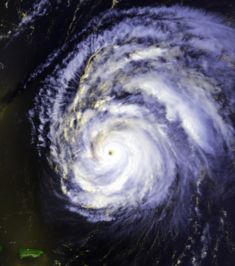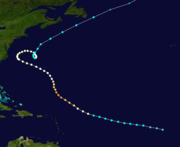Hurricane Felix (1995)
2008/9 Schools Wikipedia Selection. Related subjects: Natural Disasters
| Category 4 hurricane ( SSHS) | ||
|---|---|---|
|
Hurricane Felix near peak intensity |
||
| Formed | August 8, 1995 | |
| Dissipated | August 22, 1995 | |
| Highest winds |
|
|
| Lowest pressure | 929 mbar ( hPa; 27.44 inHg) | |
| Fatalities | 8 direct | |
| Damage | $132,000 (1995 USD) $187,000 (2008 USD) |
|
| Areas affected |
Bermuda, U.S. East Coast beaches | |
| Part of the 1995 Atlantic hurricane season |
||
Hurricane Felix was the sixth named tropical cyclone and the third hurricane of the unusually active 1995 Atlantic hurricane season. Though it never made landfall, Felix stalled off the coast of North Carolina, resulting in great uncertainty over its track. The hurricane caused eight deaths and severe beach erosion from North Carolina to Massachusetts.
Storm history
A tropical wave moved off the coast of Africa on August 6. Deep convection quickly organized around a centre, and the system developed into Tropical Depression Seven on August 8 while a short distance southwest of the Cape Verde islands. The depression moved to the west-northwest, and 18 hours after forming it strengthened into a tropical storm, receiving the name Felix. It continued to slowly intensify as it headed west-northwestward, a motion caused by the subtropical ridge, and attained hurricane status on the 11th, while 620 miles (1,000 km) east-northeast of Guadeloupe.
A split in the deep-layered trough over the western Atlantic Ocean resulted in Felix turning to the northwest. There, where warm sea surface temperatures and little upper-level shear provided conditions favorable for intensification, the hurricane began to rapidly intensify to its peak strength, with maximum sustained winds of 140 mph (225 km/h) on August 12. An eyewall replacement cycle, combined with upper level shear from its anticyclone being displaced over the hurricane, caused Felix to weaken and develop a broader inner core. Its northwest motion continued, bringing Felix, then an 85 mph (135 km/h) hurricane, within 75 miles (120 km/h) of Bermuda on the 15th.
The subtropical ridge built to the west, forcing Felix to take a west-northwest track. Initially, it appeared that the westward motion would cause Felix to strike the mid-Atlantic coastline, though a weakness in the ridge caused the hurricane to stall just 165 miles (265 km) east of the Outer Banks from August 17 to August 19. Cooler, drier air weakened Felix to a minimal hurricane, and while stationary, it presented an eye 60 to 80 miles (95 to 130 km/h) in diameter. After one shortwave trough failed to pull the hurricane towards open sea on the 18th, Felix drifted eastward, and executed a clockwise loop before another shortwave trough brought the hurricane to the northeast. Cooler waters weakened Felix to a tropical storm on August 20, and after passing to the east of Newfoundland, the storm became extratropical on the 22nd. As an extratropical storm, Felix persisted until August 25 when it dissipated between Iceland and Ireland.
Preparations
Initial forecasts predicted a landfall on the Outer Banks of North Carolina, with winds of 100 mph (160 km/h); however, these forecasts were made with great uncertainty. While Felix was still near Bermuda, officials in the United States issued hurricane warnings from Little River, South Carolina to Chincoteague, Virginia, and tropical storm warnings from Chincoteague to near Manasquan, New Jersey on August 15. Also that same day, officials in Dare County, North Carolina, ordered a mandatory evacuation for the Outer Banks, a decision that caused $4 million (1995 USD) in daily losses for local businesses. At the time, over 200,000 tourists and residents were in the evacuation zone, including 5,000 to 8,000 in Hatteras, the city furthest from the mainland by road. Had the hurricane continued on its path, it would have made landfall on the night of August 16. For this same reason, schools were cancelled throughout Dare County; further inland in North Carolina, shelters were opened in schools in Roanoke Rapids and Rocky Mount.
In southeastern Virginia, officials feared a repeat of the 1933 Chesapeake Potomac Hurricane, which caused a deadly storm surge in downtown Norfolk. Contrary to typical North Carolina hurricanes, which parallels the coast, Felix was predicted to make landfall head on, a situation known to exacerbate storm surge. The large size of the hurricane, potential for re-strengthening, and slow forward motion, caused a worst-case scenario in which 7 to 9 feet (2.1 to 2.7 m) of water would be pushed onshore and cause wide-spread flooding throughout southeastern Virginia. The projected path caused 66 U.S. Navy ships to depart the Norfolk Naval Base for safer waters.
Impact
Though Felix did not make landfall, its large circulation created large swells across much of the western Atlantic Ocean. In Puerto Rico, 8 to 12-foot (2.4 to 3.7 m) waves caused minor coastal flooding in Cataño. Strong waves and rip currents were responsible for the deaths of eight people.
Bermuda
In Bermuda, officials issued hurricane warnings about one day prior to moving past the island. The Bermuda International Airport cancelled flights during the storm's onslaught, and gusty winds downed numerous trees and power lines. Although no wind reports are available, estimates indicate that Felix produced winds of 80-85 mph (129-137 km/h) at the surface of the island. The hurricane's passage postponed the scheduled vote for Bermuda's independence. The winds left 20,000 without power initially, though power was quickly restored. Rough surf from Felix destroyed a few boats and damaged hotels on the island's southern shore, though damage was minor.
East Coast of the United States
While stalling offshore, Hurricane Felix generated strong waves of up to 15 feet (4.7 m) in Martha's Vineyard. In addition, persistent cyclonic winds caused strong rip currents along the coastline. The rip currents and strong waves caused three drowning deaths in North Carolina and five in New Jersey. The winds caused extensive beach erosion in North Carolina and New Jersey, especially in Ocean City, New Jersey where 240 feet (73 m) of beach was lost and 10-foot (3 m) cliffs were formed. In Atlantic City, beaches were closed for the first time since Hurricane Gloria in 1985. Flooding was also present in Virginia with tides 4 feet (1.2 m) above normal. Numerous other beaches from North Carolina to Massachusetts were closed, as well. Storm tides were 2.5 feet (.8 m) above normal in most locations, including the Outer Banks where North Carolina Highway 12 was flooded sporadically for four days.
Because Hurricane Felix remained offshore, it caused little property damage. Two houses in the Hamptons were washed away by the strong waves. In North Carolina, 20 to 30 houses experienced minor damage, totaling to $57,000 in damage (1995 USD, $70,000 2005 USD). Strong waves from the hurricane sunk two boats with one person each off the coast of Maine, with damage to the boats totaling to $75,000 (1995 USD). Both men swam to shore, one of whom suffered minor injuries after the crash. Strong waves also swept a woman out to sea in Bailey Island, Maine. She was rescued, but not after suffering from hypothermia and cuts over her body.
Canada
In Nova Scotia, authorities closed several beaches due to swells of up to 20 feet (6 m). Buoys near the Newfoundland coast recorded wave heights of 49 feet (15 m), while buoys further offshore reported wave heights of 82 feet (25 m). Upon moving past Nova Scotia, the hurricane dropped light rainfall of up to 1.5 inches (40 mm).
Aftermath
Due to the extensive beach erosion, government officials questioned whether to rebuild on barrier islands. In Virginia Beach, $10 million (1995 USD) was required to replenish the sand, the first restoration project since 1962. Geologists argue it is a losing battle, believing it is pointless to replace the sand lost due to nature. Others argue the beach is helping small towns with tourism, many times their primary source of income. In addition, one estimate indicated it would cost less to replace the beach than to pay for the disaster-relief when a storm might destroy unprotected houses.
Because the damage was minimal, the name Felix was not retired. It was used again during both the 2001 and 2007 seasons. The name Felix has since been retired after the 2007 Atlantic hurricane season, and has been replaced by Fernand on the list of names for the 2013 Atlantic hurricane season.


